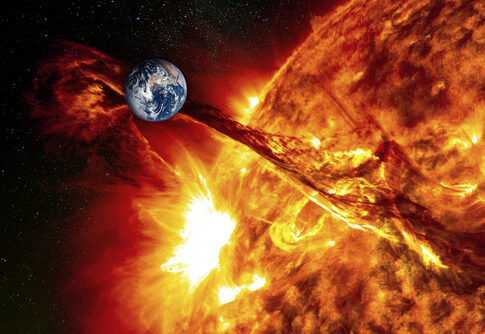In a rare and potentially disruptive event, the National Oceanic and Atmospheric Administration (NOAA) has issued a warning about an impending severe geomagnetic storm. This powerful space weather event, forecast to hit Earth starting May 10, 2024, and continuing through the weekend, could have wide-ranging impacts on technology and infrastructure across the globe.
The storm, classified as a G4 (severe) event, stems from a series of coronal mass ejections (CMEs) launched from sunspot AR3664. These CMEs are explosions of plasma and magnetic fields from the sun's corona, capable of causing significant geomagnetic disturbances when they collide with Earth’s magnetic field. NOAA’s Space Weather Prediction Center (SWPC) reported that the initial CME arrived on May 10 at 12:37 PM EDT, quickly elevating the storm to G4 levels and even briefly reaching G5 (extreme) conditions on May 11.
🚨Update: Scientists are predicting more massive Solar Storms coming our way over the next few weeks and months! One may damage or destroy the power grid!! pic.twitter.com/msvJ6yBsZy
— US Civil Defense News (@CaptCoronado) May 18, 2024
The consequences of such a powerful geomagnetic storm are extensive. Potential impacts include disruptions to communications, satellite operations, and the electric power grid. The storm may also affect navigation systems and radio communications. NOAA has already alerted operators of these systems to take precautionary measures to mitigate the storm's effects.
Additionally, this geomagnetic activity is expected to produce spectacular auroras far beyond their usual polar confines. Reports suggest that the northern lights could be visible as far south as Alabama and Northern California, a rare treat for skywatchers in these regions. These auroras occur when charged particles from the sun penetrate Earth’s atmosphere and excite gas molecules, resulting in vibrant displays of light.
🚨Update: Very serious level solar storms with a 10% chance of it being the ‘Kill Shot!’ That’s what is known among some as the Great Solar Flash, that will potentially take out the power grid for years, maybe decades! 10% is small, but still possible! Be prepared NOW!! pic.twitter.com/cLbgp8vRwn
— US Civil Defense News (@CaptCoronado) May 9, 2024
This geomagnetic storm is the most severe to affect Earth in 21 years, reminiscent of the infamous Carrington Event of 1859 and the Halloween storms of 2003. Such events are rare but can occur more frequently during periods of solar maximum, the peak phase of the sun’s 11-year activity cycle. Experts believe we are currently in a solar maximum, which increases the likelihood of more G4 or G5 disturbances in the coming years.
While the storm's immediate effects include minor power grid irregularities and temporary GPS disruptions, the broader implications for technology and infrastructure remain a concern. Satellites, in particular, are vulnerable to space weather events, with the potential for reduced operational capabilities or even damage. Ground-based systems, including power grids, could also experience significant strain.
The SWPC will continue to monitor the situation and provide updates as necessary. NOAA and NASA are closely observing sunspot AR3664, which has already produced multiple X-class solar flares, including an X5.89-magnitude blast on May 11. This sunspot is the most active of the current solar cycle, underscoring the heightened solar activity we are experiencing.
As this event unfolds, preparedness and real-time updates are crucial. NOAA’s alerts and warnings are essential tools for industries and individuals to mitigate potential disruptions. The public is advised to stay informed through official NOAA channels and space weather resources.
For more detailed information and updates on the geomagnetic storm, visit NOAA's Space Weather Prediction Center at www.swpc.noaa.gov.
What are YOUR thoughts?
We want to hear from you! Please comment below to join the discussion.

